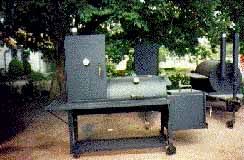National BBQ Month
 According to the National Barbecue Association, May is National Barbecue Month. It's a great idea who's time has come. I urge all of you to get out during the month of May and do you part. COOK! If you need more ideas, you can find them on the NBBA's website.
According to the National Barbecue Association, May is National Barbecue Month. It's a great idea who's time has come. I urge all of you to get out during the month of May and do you part. COOK! If you need more ideas, you can find them on the NBBA's website.(Have I posted too many pictures of ribs lately? Let me know.)
I'll be doing my part to honor National Barbecue month, so, I hereby pledge:
- To post daily.
- To post about barbecue and grilling only (with the exception of my post about the Taste of Chinatown which I promised you folks.)
- To cook barbecue and take pictures of it.
Facts on Types of Smoking Processes:
Cold Smoke:
- Smoking occurs at 70°F to 100°F, imparting flavor without firming proteins. Items may be cold smoked, then finished in the oven. 80 degrees is average in a smoke house. There will be slight dehydration but very little actual cooking.
- Smoking occurs at 160°F to 225°F, imparting flavor and cooking the product. Temperature of smokehouse 160°F for all sausage (casings) 185°F for all solid meats.
- Beef (suitable cuts) 130°F to 135°F for rare
Addition of smoke to an item that will be finished by some other cooking method.
Conventional:
- More smoke flavor, the air does not circulate as much.Product must be dry.
- Less smoke flavor because the air is being circulated.Product does not have to be dry because of the air circulation.
- Pan smoking gives a lot of flavor in short period of time. Can be done with no special equipment.
- 103°F Proteins begin to set or denature
- 137.5°F Trichinosis bacteria is killed
- 155°F Federal requirement for cooking pork
- 155°F All meats
- 160°F All proteins are coagulated
- 165°F Federal requirement for cooking all poultry


 The Kansas City Barbeque Society
The Kansas City Barbeque Society The New England BBQ Society
The New England BBQ Society The Mid Atlantic BBQ Association
The Mid Atlantic BBQ Association The Hampton Smoker
The Hampton Smoker Your guide to BBQ joints in Boston, New York and everywhere in between
Your guide to BBQ joints in Boston, New York and everywhere in between
 The Pickled Pig Forums
The Pickled Pig Forums BBQ-4-U Forums
BBQ-4-U Forums  National BBQ News Forums
National BBQ News Forums  The Virtual Weber Bullet
The Virtual Weber Bullet HomeBBQ.com
HomeBBQ.com Edible Brooklyn
Edible Brooklyn  BBQTV.com The source for BBQ competition coverage, cooking tips, sauces, rubs, grills, equipment and anything to do with barbecue.
BBQTV.com The source for BBQ competition coverage, cooking tips, sauces, rubs, grills, equipment and anything to do with barbecue.  The BBQ Guy's Blog
The BBQ Guy's Blog  The BBQ Report
The BBQ Report 

















1 Comments:
Actually, the FDA Food Code only requires "whole" pieces of meat to be cooked to 145 F. Pinned or injected meats must be cooked to 155 F.
See section 3-401.11 of the Food Code.
Post a Comment
<< Home